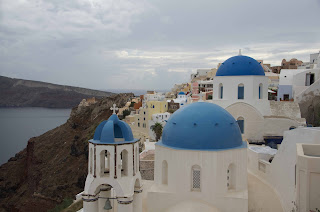We had a great tour of Santorini. I think it might be the most beautiful place we have visited and we did not see it at its best since the sky was mostly overcast all day. Small patches of blue sky just don’t provide the highlights the blues and whites deserve. Nevertheless, the beauty is still awe-inspiring. Unfortunately, these pictures only hint at the beauty.
The natural beauty of Santorini
begins with the 3500 year-old caldera created when an eruption destroyed the
cone of the volcano submerging it beneath the blue ocean leaving one
crescent-shaped island with cliffs facing west to the sunset over the remaining
small islands that draws lovers from all over the world. This natural beauty is
enhanced by the stunning architecture. Pristine white buildings topped with
arched roofs are interspersed with blue domes and the occasional red or pink
doorway. Narrow marble walkways show off the island’s wealth.
The villages of Santorini perch high
above the sea providing an interesting and perhaps scary ride or walk from
either of the two ports. From the new port cars and buses negotiate seven
switchbacks up the cliff side. Alternatives from the old port include a
recently-built gondola or a donkey ride. Riding up on a donkey might not smell
very good, but riding down can be a dicey proposition as the donkeys don’t seem
to be aware of the fact that the rider’s legs are scraping the side of the
cliff. Nor are they worried about how fast they might be going as they rush
down the trail to reach the food and water that awaits them at the bottom.
Walking is another alternative if you don’t mind the smell from that ‘stuff’
the donkeys leave behind. We chose the gondola.
 |
| One of the crew on our shuttle boat |
 |
| A huge crowd was no obstacle for this pourer |
 |
| Yes, those are tasting glasses. |
From there we drove along the coast
to Oia, the town everyone who ever had an inkling about visiting Greek Isles
has seen pictures of. A picture of this white-walled village with its iconic
round blue rooftops adorns most travel agency walls and every website that has
anything to do with the Greek Isles. Blue and white are the colors of the Greek
flag so when the country has been conquered by outsiders this was a way to show
patriotism. Today, it is probably the law.
 |
| The old fort |
Nightlife is concentrated in Fria,
the capital city, but both Fria and Oia have many restaurants and tavernas to
choose from. Guests staying anywhere on the island make sure they have a table
in one of them to watch what must be one of the most romantic sunsets anywhere.
If not in one of the restaurants, they will be sitting on one of the many
terraces at Santo Winery. We stopped at one of these restaurants in Fria for a
couple of drinks. While we did not get to see one of classic sunsets, we were
still treated to some drama as the clouds did part enough to show us what we
can look forward to on our next visit.








































